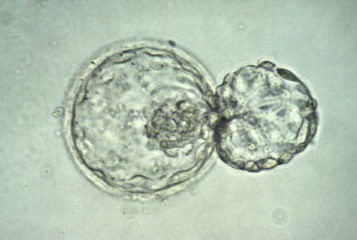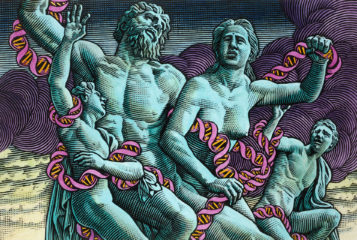Chairing the final session of the 2023 PET (Progress Educational Trust) Annual Conference – 'How Much Change Do We Want? Updating Fertility, Embryo and Surrogacy Law'- was Danielle Hamm, director of the Nuffield Council on Bioethics. She discussed the fact that scientific advances raise new and profound ethical and legal challenges, that must be navigated with care. The session explored building consensus on how to proceed with law reform .
The first speaker – Professor Susan Golombok, emeritus professor of family research at the University of Cambridge – discussed the question of when and how donor identity should be released, given recent proposals by the Human Fertilisation and Embryology Authority (HFEA) to make donors indentifiable from the birth of the donor-conceived child (see BioNews 1216).
What impact might such a policy have, on parents and donor-conceived people? Professor Golombok reminded us that we do not yet know the outcome of making donors identifiable once the donor-conceived child turns 18 (see BioNews 1208), and argued that the views of those affected (children, parents and donors) are important going forward. Would they have liked to have this information earlier? What if the parents and children disagree over contact? What happens if the donor doesn't want to meet the child?
Research suggests that one third of parents of children with identifiable egg donors see identity-release as threatening. However, the same research also suggests that one third of parents accept identity disclosure and one third actively embrace it. Studies involving children born through egg donation show that if the donor's identity is available earlier, then a significant number will want to have contact. At younger ages, most children don't understand what it means to be donor conceived but by their teens they acquire a much better understanding. Many want to meet their donor in order to get a better understanding of themselves. Professor Golombok said while there are advantages to the donor's identity being released before the child reaches 18, most mothers had not told their their donor-conceived children about their origins at a young age. This suggests that most would be unlikely to request the donor's identifiable information in early childhood.
Next to speak was Dr Sarah Chan, associate director of the University of Edinburgh's Centre for Biomedicine, Self and Society, who discussed the regulation of human embryo research and the creation of embryo-like structures. These structures pose a problem for regulation, said Dr Chan, because they need to both be the 'same enough' to mimic features of the human embryo for research purposes but 'different enough' so that we can do things that we can't do with human embryos. If they are like 'embryos', then should we regulate them like embryos? This gives rise to questions over how to define an embryo, and how definitions and terminology are incorporated into regulation.
Dr Chan pointed out that the regulatory question 'What is an embryo?' is not the same as what the moral question 'What is an embryo?'. Aspects of embryos including their origin, development and reproductive destination all help to determine for regulatory purposes what an embryo is, but we must also ask what regulation is doing, and what it is perceived to be doing. There is a performative aspect to regulation and governance, Dr Chan explained, not in the sense that these things are tokenistic but rather in a sense that carries significance all of its own.
Next to speak was Dr John Appleby, lecturer in medical ethics at Lancaster University, who asked whether the 14-day rule is fit for purpose or whether – as has been suggested in the Netherlands (see BioNews 1214) – we should extend it to 28 days. Dr Appleby said there were no compelling moral reasons not to extend, and there are good moral reasons for an extension, including the need to understand human development between 14 and 28 days.
Would such a move damage trust? Dr Appleby argued that the opposite is the case, saying that an unwillingness to update science in line with people's needs is untrustworthy behaviour. In his view, extending the 14-day rule is important for perceptions of reliability in policy reform and cultivating a feeling of trust in policymakers. The safety and progress of valuable science should be our aim, he said. In the context of regulation, people do not place their trust in rules, but rather in the people who are engaged in the process of reviewing and revising the rules. It is these people who can help to ensure that rules do what we expect and uphold our interests.
The final speaker was Bobbie Farsides, professor of clinical and biomedical ethics at Brighton and Sussex Medical School, who made the case for ethical 'preparedness' for scientific and regulatory changes. Professor Farsides defined preparedness as a state in which one can identify and articulate ethical issues in a timely and ongoing manner. This includes possessing the tools and experience to address the issues in question, an awareness of whom to consult with to gain expertise, and engagement with professional bodies, regulators and patient groups.
Professor Farsides said we must consult scientists, who want clarity around their working environment, while also understanding the relationship between public trust and the way emerging issues are dealt with. Ethical preparedness also engages the public. Public interest in and engagement with science have grown considerably, and people have become very engaged with the issue of the 14-day rule (see BioNews 1213). Professor Farsides concluded that if we are to be ethically prepared for change, the role of PET is an important one.
The questions that followed picked up on the theme of regulatory horizon scanning. Speakers were asked whether there should be clear lines of governance in place before an embryo model is allowed to develop into (the equivalent of) a fetus. Dr Chan replied that regulation has shifted from being retroactive to being proactive, adopting a precautionary approach but drawing the line such that it remains possible to 'see over the fence' and decide where we might want to go.
Speakers were also asked whether changes to the 14-day rule should be included explicitly in a reformed HFE Act immediately, or whether – as the HFEA has suggested – a regulation-making power should instead be introduced into the Act, enabling such a change to be made further down the track. Professor Farsides responded that since law reform will take some time in any case, we should use that time to take the heat out of the debate, and explore why some scientists wish to change the rule. Dr Chan added that a first step might be to accept this is something that can be changed, opening up the way for the actual change to be made later.
Another question was there any difference between the disclosure of donor identity in the context of mitochondrial donation and in the context of donor conception. Professor Golombok thought that there was a difference, but that this difference did not preclude deciding to remove anonymity for mitochondrial donors as well.
Dr Appleby was asked whether there was a moral difference between a human embryo being created specifically for research, and an unused embryo that was created originally for use in treatment but was then donated to research (see BioNews 1219). Dr Appleby replied that there is a difference in the value that each type of embryo holds for the people whose gametes were used to create it, but that the embryos do not differ in their intrinsic value, notwithstanding religious perspectives on the issue.
This concluding session of the PET conference highlighted the complexity of regulatory change, and the importance of thorough engagement with the general public and with others who are impacted. Tjr event was an excellent example of how debate can help to build the agreement needed for ethically sound and effective law reform.
PET would like to thank the sponsors of this session (the Anne McLaren Memorial Trust Fund) and the other sponsors of its conference (the Edwards and Steptoe Research Trust Fund, ESHRE, Hertility, Born Donor Bank, Carrot Fertility, Ferring Pharmaceuticals, Merck, Theramex, the Association of Reproductive and Clinical Scientists, and the Institute of Medical Ethics.).
Register now for PET's next free-to-attend event, Fertility Treatment for Single People: Who Should Pay?, taking place in Edinburgh on Wednesday 10 January 2024.







Leave a Reply
You must be logged in to post a comment.